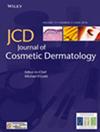A Case Series With Cysteamine–Isobionicamide Complex: Clues for Skin-Rejuvenating Activity
Abstract
Background
Skin aging is inevitable. Wrinkles, skin texture abnormalities, senile hyperpigmentation, loss of skin tone, dryness, atrophy, and telangiectasias represent some of the hallmarks of aged skin. Skin rejuvenation can be addressed by topical therapies, such as topical retinoids and antioxidants or physical modalities with energy-based devices, all providing acceptable outcomes. In this case series, we aimed to test the rejuvenating potential of the combination of cysteamine (a naturally occurring antioxidant) and isobionicamide (a derivative of the anti-aging molecule niacinamide) applied topically.
Methods
Healthy male and female patients (N = 7) aged between 25 and 70 years and having Fitzpatrick skin types I–VI were recruited. Topical application of a cysteamine-isobionicamide formula was done once daily. Treatment lasted for 16 weeks. Clinical high-resolution photos were acquired using LifeViz 3D at recruitment and after 16 weeks. Blinded dermatological examinations and scoring were performed. Self-assessment and quality of life (QoL) questionnaires were collected.
Results
Clinical photos showed improvement in skin luminosity, increased evenness of skin tone, and reduction of fine wrinkles as well as hyperpigmentation. Patients as well as clinical investigators blinded to the chronology of photos observed the improvements in skin texture, luminosity, and radiance, the brightening of the dark spots, as well as the reduction of both number and volume of wrinkles after 16 weeks of daily application. Furthermore, a significant improvement in patients' quality of life was recorded.
Conclusion
This case series represents the first evidence that topical application of cysteamine isobionic-amide complex could be considered as a safe and effective option in the reversal of skin photoaging.


 求助内容:
求助内容: 应助结果提醒方式:
应助结果提醒方式:


